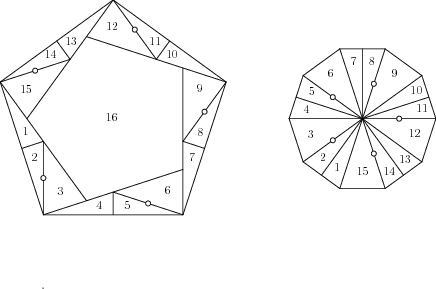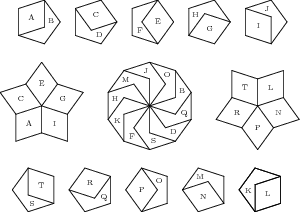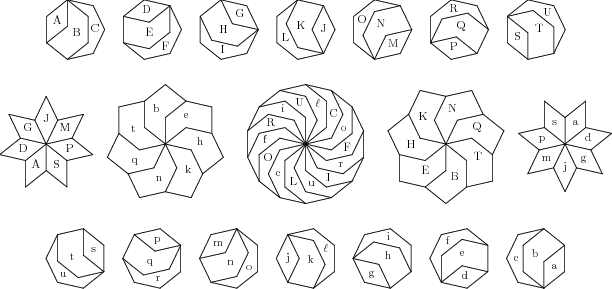
It is possible to add swing hinges and twist hinges to the dissection of a regular pentagon and a regular decagon to a larger regular pentagon that we find in Plate 178. I didn't include twist hinges in this book, but you can find such a discussion, with many examples of twist-hinged dissections in my second book Hinged Dissections: Swinging and Twisting
In the next figure, you can see the large pentagon and the decagon. (I don't show the small pentagon separately, because we don't cut it.) A twist hinge, represented by a small open circle, will be positioned on an edge shared by two adjacent pieces. The twist hinge allows one of those pieces to rotate by 180 degrees, whereby that piece rotates up, out of the plane, and then back into the plane. Thus you can see, for example, that there is a twist hinge connecting pieces 5 and 6, and that piece 5 stays in the plane, while piece 6 will rotate out of the plane and back down again so that its apex will then be adjacent to the small angle of piece 2. (Pieces 7 through 15 will also tag along, thus sharing the movement of piece 6.)

We see a more complete description of the hinged pieces from the decagon in the following figure. You can see that there is a swing hinge between pieces 1 and 2, between pieces 4 and 5, between pieces 7 and 8, between pieces 10 and 11, and between pieces 13 and 14. There is also a swing hinge between pieces 2 and 4, between pieces 5 and 7, between pieces 8 and 10, and between pieces 11 and 13. However, those last four swing hinges do not connect pieces 3 and 6 and 9, and 12 to any other pieces. (This is indicated in the figure by setting those latter four hinges slightly above pieces 3, 6, 9, and 12.) Of course, because of the connection of the twist hinges, piece 3 will remain connected with piece 2 whenever piece 2 moves. And similarly, for pieces 5 and 6, pieces 8 and 9, pieces 11 and 12, and pieces 14 and 15.

Thus by an appropriate sequence of swings and twists, we can convert the decagon to a ring of pieces forming the outline of the large pentagon, and then finally drop the small pentagon (piece 16) into the center.
It is possible to orient the 10 regular pentagons and three decagons in Plate 178 so that the resulting orientation is clearly translational, as we see in the following figure:

There is an analogous dissection of 14 regular heptagons to a regular 14-sided polygon, two 7-pointed pseudo-stars whose points are of 360/7 degrees, and two 7-pointed pseudo-stars whose points are of 720/7 degrees. Again, all side lengths of these figures are equal. It is possible to orient these various polygons so that the resulting orientation is clearly translational, as we see in the following figure: (Note that I name the pieces with both lower-case and upper-case letters. To distinguish between the upper-case "I" and the lower-case "l" which can look very similar, I have represented the lower-case "l" with the lower-case "script l". It is not meant to be a "script e" !)

These two dissections would seem to be part of an infinite sequence of dissections, starting actually with a dissection of 6 equilateral triangles to a regular hexagon. The dissection following the one above for heptagons would be a dissection of 18 regular 9-sided polygons to a regular 18-sided polygon, plus two 9-pointed pseudo-stars whose points are of 360/9 = 40 degrees, two 9-pointed pseudo-stars whose points are of 720/9 = 80 degrees, and two 9-pointed pseudo-stars whose points are of 1080/9 = 120 degrees. I leave verification of the general conjecture to energetic readers!
Copyright 2019, Greg N. Frederickson.
Permission is granted to any purchaser of
Ernest Irving Freese's Geometric Transformations:
the Man, the Manuscript, the Magnificent Dissections!
to print out a copy
of this page for his or her own personal use.
Last updated January 11, 2019.